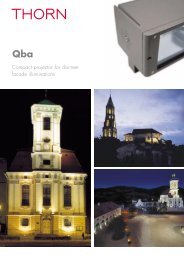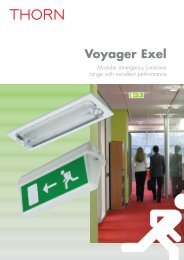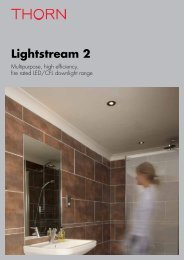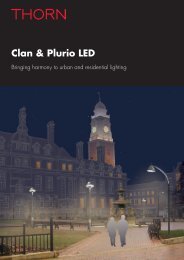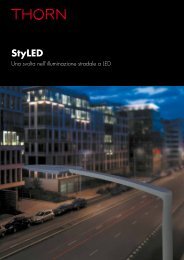Create successful ePaper yourself
Turn your PDF publications into a flip-book with our unique Google optimized e-Paper software.
Performance<br />
The ‘Performance’ component of PEC addresses the visual<br />
effectiveness of the lighting scheme in performing the required<br />
task, wherever that may be. Menlo³’s comprehensive range allows<br />
schemes to be tailored to a particular task or remain flexible enough<br />
to accommodate variability.<br />
Thorn’s PEC philosophy for Office <strong>Lighting</strong><br />
Successful modern office developments give equal<br />
importance to financial, environmental and social concerns<br />
and good office lighting design makes an important contribution<br />
to an economic and productive working environment, being<br />
linked to 15% reductions in absenteeism and 3-20% increases<br />
in productivity (Source: BCO/CABE)<br />
Menlo³ fully embodies Thorn’s PEC approach to office lighting, marrying<br />
user comfort and performance with scheme efficiency.<br />
Sophisticated materials and optical design make building efficiency<br />
targets easy to achieve, enabling designers to focus on personal and<br />
environmental factors that affect employees.<br />
With a wide choice of optics, mounting options and styling, Menlo³ not<br />
only provides appropriate task lighting but also creates a stimulating<br />
and pleasant lit working environment for people. This holistic approach<br />
all adds up to reduced absenteeism and staff turnover, increased<br />
satisfaction and productivity and ultimately lower costs.<br />
Saving money, and the planet<br />
It is generally assumed that being green costs money. Menlo³ is an<br />
example of how truly sustainable product design is concerned with<br />
minimising the use of materials, resources and energy which<br />
collectively reduces costs over time.<br />
It starts with efficient light sources such as T16 lamps or LED<br />
technology that produce high values of lumens/watt. It is then essential<br />
that the maximum amount of useful light is produced by minimising<br />
losses within the fitting and directing it to where it is required. The<br />
sophisticated optical design of Menlo³ achieves light output ratios as<br />
high as 86% and luminaire efficacy up to 62 luminaire lumens per<br />
circuit watt (lm/W). These efficiencies result in fewer fittings to light the<br />
space, using less raw materials and resources and reducing installation<br />
and operating costs.<br />
We then add highly efficient electronics and lighting management<br />
technology. Moving from conventional magnetic technology to<br />
electronic ballasts and T16 lamps can give an energy reduction of up<br />
to 40%. Menlo³ offers DSI or DALI dimmable gear as standard, which<br />
when linked with presence and daylight detection can achieve energy<br />
savings over 70% (Source: CELMA).<br />
The EU Directive on the Energy Performance of<br />
Buildings (EPB) contains a range of provisions aimed at<br />
improving energy performance of residential and<br />
non-residential buildings.<br />
Although the EPBD must be implemented by each EU Member<br />
State, the method of implementation is up to individual countries,<br />
such as the Part L of the UK Building Regulations.<br />
Approved Document Part L requires that for office, industrial<br />
and storage areas luminaire performance shall be at least 55<br />
luminaire lm/W and other types of spaces require a performance<br />
of at least 55 lamp lumens per circuit watt.<br />
Menlo 3 ensures future proofing of design by most of the variants<br />
exceeding 55 luminaire lm/W and all variants exceeding 55 lamp<br />
lumens per circuit watt.<br />
Furthermore with the inclusion into Part L2A of the controls factor<br />
already used in Part L2B, all Menlo 3 luminaires will comply with<br />
Part L requirements when used in conjunction with lighting controls.<br />
Innovation in product design is matched with equally innovative<br />
manufacturing techniques such as deep drawing the shallow 70mm<br />
depth body and producing the mini-vane louvre in one piece. All of<br />
this contributes to reduced materials, wastage, energy use and CO 2<br />
emissions for a truly sustainable luminaire.<br />
4



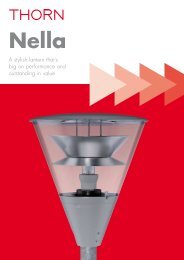
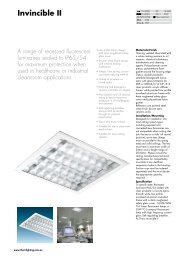
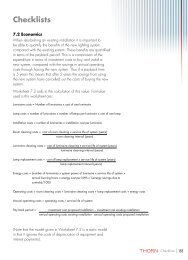
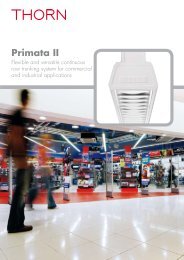
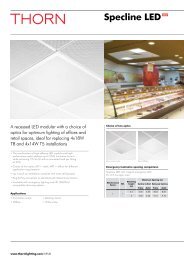

![Produkt brochure [PDF/4MB] - THORN Lighting](https://img.yumpu.com/50705283/1/184x260/produkt-brochure-pdf-4mb-thorn-lighting.jpg?quality=85)
